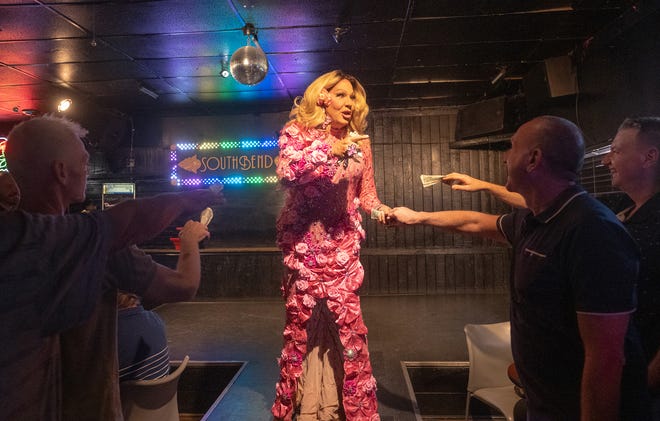
John Rogers was asleep in the backseat when a Columbus police officer pulled over his brother late on a Saturday night in April 1973. The officer tapped Rogers on the shoulder to wake him up.
In the mercury vapor light of an alleyway north of Bryden Road, the officer took in what Rogers was wearing: dark palazzo pants, a blouse with a print of tiny flowers, a pink three-quarter-length pullover sweater and a black wig styled in a funky shag. The officer knew what a funky shag was because his wife wore the same style. She also wore palazzo pants.
“Those are women’s clothes you have on,” he told Rogers.
“No, they’re not,” Rogers replied. “They’re my clothes.”
In 1973, it was against the law in Columbus for a man to wear palazzo pants, just as in previous generations it had been illegal for men to wear poodle skirts, flapper dresses, high lace collars, corsets, bustles and petticoats. It was illegal for women to wear men’s clothing, as well.

John H. Rogers was arrested that night and convicted later that year in Franklin County Municipal Court under what was known short-handedly as the city’s “improper-dress law.” In full, it read: “No person shall appear upon any public street or other public place in a state of nudity or in a dress not belonging to his or her sex, or in an indecent or lewd dress.”
At trial, the arresting officer testified that Rogers appeared to have a bra on under his blouse and sweater and also spoke in a soft, feminine voice. “I felt that … any time this gentleman dressed the way he was, any time he wanted to [he] could walk into a women’s restroom,” the officer said of Rogers. “He would go completely unchallenged. He could go anyplace out of the view of men.”
Judge Frank Reda found the 22-year-old guilty and fined him $25—the equivalent of more than $170 today.
Rogers, though, was the last in a long line of people convicted under the improper-dress law, which had been on the books in Columbus since 1848. It was enacted during a period of rapid growth and industrialization for the young city as part of a sweeping ordinance “to suppress immoral practices.” The law also banned prostitution, begging, banging on kettles or ringing bells to disturb the peace, and using bawdy language.
The improper-dress ban was quietly taken off the books in 1974 and declared unconstitutional by the Ohio Supreme Court in 1975 after Rogers appealed his conviction. It seemed for much of the last half-century to be a quirky, amusing relic of a more repressed 125 years. But in an era of drag bans nationwide and armed protests outside drag performances locally, that old law doesn’t seem so distant anymore.

➽ “All this is purely theater,” Sonya Ross says as the seats fill at Southbend Tavern, a corner bar in Merion Village that calls itself “the best little show bar in Columbus.” “I’m a gay man with a gay husband.” In a beaded gown and blonde wig, Ross is ready to take the stage; Jennifer Foxx is still sans wig, wearing a bathrobe and putting on makeup.
Four drag queens who bill themselves as the Golden Girls are performing this Sunday afternoon in late September for a show celebrating Ross’ 64th birthday. They’ve performed for a combined 190 years and have been around for a combined 265. “I’m the youngest,” Ross is quick to say.
They’ve all got stories to tell, from Columbus, where Ross migrated after graduating from Marshall University in West Virginia, and from the others’ hometowns, as well. Foxx is from Detroit, Twila Starr is from Toledo, and Denise Russell is from Akron.
Even after cities did away with improper dress laws in the 1970s, they say, men performing in women’s clothing were advised to wear at least one article of men’s clothing onstage. In Detroit, Foxx says, they had to wear three, and police were known to check.
Ross was told by drag performers when she first took the stage in 1978 that in Columbus they were required to wear one article of men’s clothing onstage, even though improper-dress laws across Ohio had been gone for three years by then.
In their 1975 ruling, Ohio Supreme Court justices declared that times had changed. “At the present time, clothing is sold for both sexes which is so similar in appearance that a person of ordinary intelligence might not be able to identify it as male or female dress,” their opinion read.

The chilling effect of the old law remained, though, Ross recalls. Performers didn’t necessarily know the rules, she says, and police either didn’t know or didn’t care. Ross was pulled out of a Columbus Pride parade in the early 1980s for what police told her was indecent exposure.
“I kept telling them, ‘Honey, you better call your boss. What you’re doing right now is violating my civil rights,’ ” she says. “They left me alone.”
➽ Men dressed in women’s clothes—and, occasionally, women dressed in men’s clothing—weren’t so lucky during their run-ins with police in the decades prior. And arrests under Columbus’ improper-dress law were the type of man-bites-dog story, apparently, that reporters checking the police blotter found hard to resist:
- In October 1947, the Columbus Evening Dispatch reported the arrest of a 21-year-old man on South High Street who had been wearing a blonde wig, red satin evening gown and long white gloves. He told the judge he had been invited to a Halloween party and wanted to see how he would look. He was fined $10.
- In September 1949, a 23-year-old man from Xenia was arrested at the Ohio State Fair in women’s clothes. State patrolmen noticed that his legs “were not shaped like those of a girl and that his skirt was shorter than the prevailing fashion,” the Dispatch reported. Fine: $10.
- In June 1959, a 20-year-old woman from Melbourne, Florida, and a 23-year-old woman from Atlanta were arrested in men’s clothes while hitchhiking through town. They were headed out West to look for work, they told the judge, and they said it was easier to get rides if they looked like men. Their fines were $10 each.
- In December 1971, three male Ohio State University students were arrested in long gowns at a dance sponsored by OSU’s Gay Activists Alliance. They won an appeal in the Franklin County Court of Appeals, although judges rejected their argument that gay people were denied civil rights. The judges ruled instead that because the men had beards, it was obvious they were not women.
Dispatch columnist Johnny Jones wrote in 1942 that the improper-dress law could affect pants-wearing women, suggesting, “You girls who are wearing slacks had better organize a committee to speak to the members of City Council some Monday evening.” He pointed out that Red Cross first-aid classes required women to wear pants and that aircraft manufacturer Curtiss-Wright Corp. and other industrial plants encouraged women to wear them on the job.
He didn’t argue seriously against the law. “The only objection that I have is that it is a shame to cover up those shapely limbs,” he concluded, “and I’m sure Broad and High won’t be so interesting now on windy March days.”
Columbia Law School lecturer Kate Redburn, who has documented the legal advances of those she terms “gender outlaws,” wrote last year in the journal Law and History Review that the apex—and the beginning of the end—for improper-dress laws came in the 1960s. Local governments sought during that decade to punish gender nonconformity in many forms, she wrote: “for feminists, countercultural hippies, cross-dressers (or ‘transvestites’) and people we would now consider transgender.”
And the gender outlaws started fighting back, Redburn wrote. A 1969 challenge to the Columbus law by a 25-year-old who had been arrested for the fourth time in women’s clothes was rejected by Municipal Court Judge Bruce Jenkins, who ruled: “There are numerous subjects who want to change their sex identity in order to perpetrate crimes of homicide, rape, robbery, assault, etc.”
Rogers testified at his 1973 trial that he had been arrested six or seven times before for improper dress. He said he was “attracted to men like females are,” had visited a psychiatrist and was taking hormone pills. He said he would have undergone electrolysis and what’s now called gender-confirmation surgery “if I could afford it.”
His lawyer, Max Kravitz, argued that arresting people because of their clothes, voice and mannerisms was plain wrong. “He was just being how he is, and I don’t think the statute intends to punish someone for being how they are.”
➽ Historians aren’t sure exactly what prompted cities around the country to police people’s clothing in the mid-19th century. Clare Sears, an associate professor of sociology and sexuality studies at San Francisco State University, identified Columbus as the second city in the nation, after St. Louis in 1843, to adopt an improper-dress law.
It was the beginning of the Victorian age in Great Britain but the beginning of a women’s dress-reform movement in the United States that tried to do away with the long skirts that dragged across the ground in favor of loose trousers under shorter skirts or dresses. Local governments across the country sought during that era to “impose their vision of social order onto city space,” Sears wrote in Arresting Dress, a 2014 book about a similar law in San Francisco.
Editors and readers of the Ohio State Journal in 1851 had an ongoing debate in the pages of the newspaper about dress reform, but no one mentioned the Columbus law that had been in place for three years. It’s clear this time around, though, that protests and proposed legislation against drag performances and access to gender-affirming treatment for transgender Americans are directly tied to cultural shifts in Ohio and across the nation.

The Berwick Ball, an underground Halloween drag party founded in 1964 by David Zimmer and Orn Huntington, evolved into a respected showcase and fundraiser during the AIDS epidemic. Columbus banned discrimination based on sexual orientation in 2000 and gender identity in 2008, and support for such protections across the country stood at 80 percent last year, according to a poll by the Public Religion Research Institute. Columbus drag queen Nina West, performed by actor Andrew Levitt, has a street named in her honor in the Short North and has partnered with Lane Bryant to sell Pride merchandise. RuPaul’s Drag Race, a reality-TV competition that turned Levitt into a national celebrity, reached its highest ratings with this year’s 15th season.
Meanwhile, the Equality Federation reports 38 bills in 16 state legislatures this year to police drag performances. Bills that would be harmful to transgender children or adults have been introduced in all 50 states, the group says.

➽ Nearly 50 years after the demise of the city’s improper-dress law, Linda Cox isn’t so sure authorities have stopped policing gender in Columbus.
At Columbus Pride in 2017, Cox claims she was deliberately shoulder-checked twice by Columbus police officers, one of whom told her to “get the f— out of my way” and threatened to arrest her. It was the same year that four queer, Black protesters were arrested by police while trying to call attention to violence against queer, Black people.
And before a federal judge ruled in 2020 that transgender Ohioans have the right to correct the gender marker on their birth certificates, Cox was certain the discrepancy between her name and appearance and her official records was the reason she’d occasionally get pulled over.
“You can’t call it racism, but it’s in the same place,” she says.
Cox is a 68-year-old transgender woman who grew up in Columbus. She came out and started living “24/7,” as she says, 25 years ago. “I was cross-dressing way back when, though.”
She holds up four fingers when asked at what age she realized she was a female and not how the world saw her. Sometimes, she’d pull her sister’s clothes out of a hamper in the bathroom. “I’d put those clothes on and look in the mirror and think, ‘There you are.’ ”
Cox remembers buying tight bell-bottoms from Schottenstein’s on Parsons Avenue. “My mom kept saying, ‘You need to get different jeans, because I can’t tell if you’re a boy or a girl.’ ” She laughs. “I thought, ‘Your point is…?’ ”
Sometimes, before her 24/7 days, she’d change in the car and just drive around in women’s clothes. Sometimes, groups of trans women and cisgender men who enjoyed cross-dressing would get together at someone’s home. “We’d get dressed up, sit around and drink beer.”
Cox also recalls when she started visiting gay bars in women’s clothes during the 1970s. The improper-dress law was gone by then, but hostility toward transgender people remained. She feared not only getting stopped by police but also what could happen inside what was supposed to be a safe space.
“I used to go to the Eagle. It had to be on a drag night,” Cox says, referring to the closed bar in Downtown Columbus. “I wanted to go out one night, and it wasn’t a drag night, and two gay guys grabbed me, dragged me outside, beat the s— out of me.”
She was assaulted again a month later at the same bar.
➽ “You better put a shirt on over that in the car,” my partner told me as I got ready to head out in August to the Mrs. Roper Pub Crawl, a local version of a national gay-bar craze. Participants dress in long, bright-colored caftans, gaudy jewelry and red, curly wigs like the landlady from the 1970s sitcom Three’s Company.

My plus-sized caftan wasn’t the flowy number I’d imagined when I ordered it from Amazon—or maybe my plus-sized body was just claiming too much of the fabric. But it was loud: tie-died, rainbow-colored, “reminiscent of the 3D color radar of an approaching hurricane,” as one friend put it.
In other words: perfect for the occasion. (So perfect that two other men showed up in the same outfit.)
I slipped a T-shirt on over it. I deposited my plastic beads and sparkly bangle inside my wig and slid the whole bundle onto the passenger seat. Around the corner from the Tremont Lounge, I sat and pondered whether to put on the wig and jewelry before or after I walked to the bar.
Did the 21-year-old in the red satin dress and long white gloves worry this much before his brief stroll on South High Street that night in October 1947? He was arrested near his apartment, which was just up the street from where the Tremont is today.
Was he really in a Halloween costume, or was he dressing the way he had always wanted to? I don’t know how he identified—gay or straight, cisgender or transgender—but I do know Halloween has always been a favorite holiday in the LGBTQ+ community because it made improper-dress laws pretty much impossible to enforce. Maybe he miscalculated that Oct. 25 was close enough.
I put on the wig.
➽ Bobby Campos didn’t grow up with the idea that clothing is separated into men’s and women’s, boys’ and girls’. “For me, gender and clothing have nothing to do with each other,” the 34-year-old says. “When I go shopping, if I lean over into the women’s department and I see pants or a nice jacket or something I think is going to look flattering on me, I don’t even think twice about the label of what it is.”
Campos came out as gay at age 12. He was harassed at his junior high school in Toledo, and his family struggled to accept his identity, although they’re loving and supportive now. He still did his own thing. He bought himself a lime green tote bag with “I Love Boys” printed on it. “I remember it being, let’s just say flamboyant,” he says.
He came of age wearing skin-tight women’s jeans, flowy tops and hair that went from bleach-blonde to orange to black. “I’m not going to change who I am because of society’s rules and standards that you have to wear one style of clothing or the other. I never believed in that. I still don’t believe in that.”
Campos, who performs as Ava Aurora Foxx and currently holds the title of Miss Gay Black Ohio, is on the front lines of today’s culture war skirmishes over drag and gender expression. Last December, he says, he received death threats from right-wing extremists over plans for a children’s story hour at First Unitarian Universalist Church in Clintonville. The event was canceled at the last minute, but protesters carrying rifles and dressed in combat gear gathered anyway across the street. They were encouraged by the Ohio Chapter of the Proud Boys. It was the first of three armed protests at Columbus drag events in the past year. Armed Proud Boys members also carrying Confederate flags gathered outside St. John’s United Church of Christ in December, but a performance by drag artist Anisa Love wasn’t affected.
In May, protesters affiliated with a national neo-Nazi group chanted outside Land-Grant Brewing Co. in Franklinton during a drag brunch hosted by Love and Virginia West. They carried a flag with a swastika and a banner that said, “There Will Be Blood.” State lawmakers have taken a stand against drag performances, too. In July, 43 Republican members of the Ohio House introduced a bill that would put drag queens in the same category of entertainers as strippers and topless dancers and ban drag performances from parks, parades and other public places. Voters in Bellefontaine, a city of around 14,000 about 50 miles northwest of Columbus, were to vote on a similar proposal in November, but the Ohio Supreme Court scrapped the ballot initiative in early October.
Campos expresses no fear. “People see that the world is moving in the right direction—sometimes—and they see we’re being progressive,” he says. “It’s always going to come up in the conversation somewhere in a really bland room with a bunch of people who have nothing better to do. All of them will probably be in gray and black suits with really boring ties.”
➽ On late Monday afternoon in October, City Council President Shannon Hardin is sitting in that proverbial bland room, in a wooden chair at a wooden conference table, surrounded by wooden bookshelves that stand against wood-paneled walls. His suit is gray-ish; his pink plaid tie is definitely not boring.
In 1848, Robert W. McCoy, “one of the earliest, most honored and most successful merchants of Columbus,” according to one early history, was serving in his 14th year as council president when he presided over passage of “An Ordinance to Suppress Immoral Practices.” Under glass on the table in front of today’s council president is a map of Columbus from the century sandwiched between his era and McCoy’s. Printed in 1936, it depicts a red-lined city in which lenders had government’s permission—its encouragement, even—to deny federally backed loans in predominantly Black neighborhoods.
It’s a constant reminder to the city’s first Black, gay officeholder to be as determined in expanding rights and opportunities as some of his predecessors were in denying them. “It’s important for us to be students of history,” he says.
The history of the city’s improper-dress law is new to him, but Hardin sees its echoes clearly in debate at the Statehouse and elsewhere in 2023. In June, he and Ohio Senate Minority Leader Nickie Antonio met in City Council chambers with other LGBTQ+ elected officials from around the state to discuss how to fight back.
“One of the things that’s so painful to many of us is it seems we have fought these fights before,” Hardin says. “One of the things that’s encouraging is the knowledge that we have beaten this before, and we can beat it again.”
This story is from the November 2023 issue of Columbus Monthly.
This post was originally published on this site be sure to check out more of their content.








